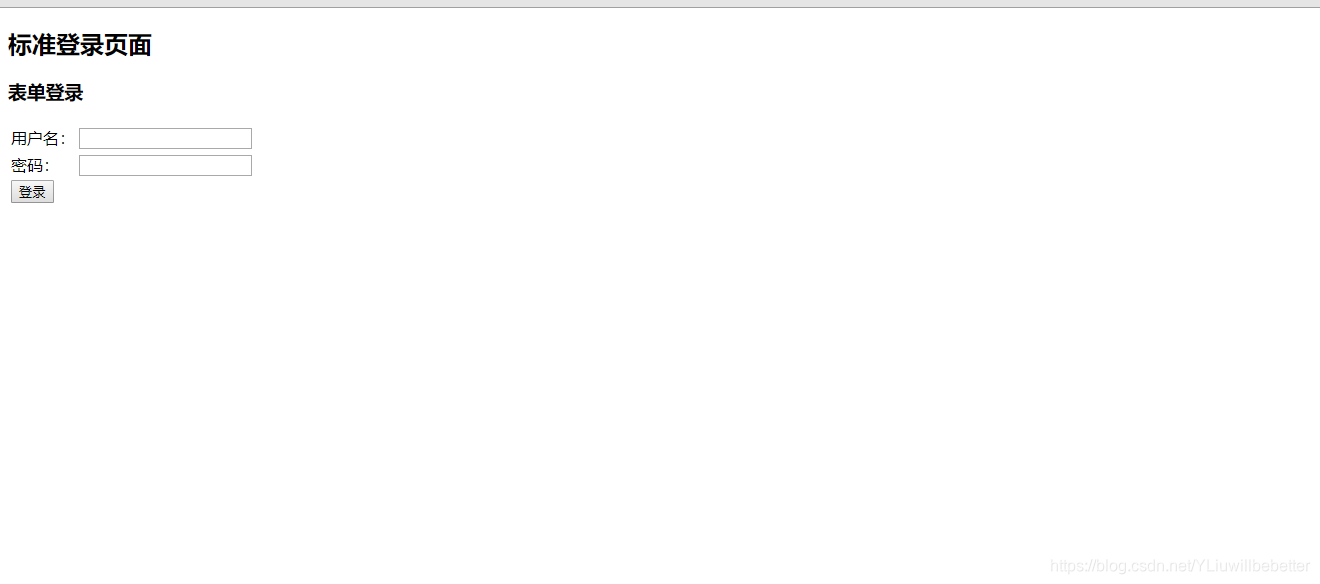Spring Security
Posted 留有痕迹~
tags:
篇首语:本文由小常识网(cha138.com)小编为大家整理,主要介绍了Spring Security相关的知识,希望对你有一定的参考价值。
Spring Security(三)
个性化用户认证流程
自定义登录页面
在配置类中指定登录页面和接收登录的 url
@Configuration
public class BrowserSecurityConfig extends WebSecurityConfigurerAdapter {
@Bean
public PasswordEncoder passwordEncoder() {
return new MyPasswordEncoder();
}
@Override
protected void configure(HttpSecurity http) throws Exception {
// 启用表单登陆
http.formLogin()
// 指定登录页面
.loginPage("/imooc-signIn.html")
// 登录页面表单提交的 action
.loginProcessingUrl("/authentication/form")
.and()
// 对请求做授权
.authorizeRequests()
// 访问指定url时不需要身份认证(放行)
.antMatchers("/imooc-signIn.html").permitAll()
// 任何请求
.anyRequest()
// 都需要身份认证
.authenticated()
.and()
.csrf().disable();
}
}- 在项目中新建登录页面
<!DOCTYPE html>
<html lang="en">
<head>
<meta charset="UTF-8">
<title>登录</title>
</head>
<body>
<h2>标准登录页面</h2>
<h3>表单登录</h3>
<form action="/authentication/form" method="post">
<table>
<tr>
<td>用户名:</td>
<td><label>
<input type="text" name="username" />
</label></td>
</tr>
<tr>
<td>密码:</td>
<td><label>
<input type="password" name="password" />
</label>
</td>
</tr>
<tr>
<td colspan="2">
<button type="submit">登录</button>
</td>
</tr>
</table>
</form>
</body>
</html>启动项目时再访问 Security 就会跳转到你自已定义的登陆页面让你登录。

- 深入定义(判断是PC端还是移动端,PC端跳转页面,移动端响应 json)
创建一个控制器,用来处理操作
@RestController
public class BrowserSecurityController {
private static final Logger log = LoggerFactory.getLogger(BrowserSecurityController.class);
private RequestCache requestCache = new HttpSessionRequestCache();
private RedirectStrategy redirectStrategy = new DefaultRedirectStrategy();
/**
* 当需要身份验证时跳转到这里处理
*/
@RequestMapping("/authentication/require")
@ResponseStatus(code = HttpStatus.UNAUTHORIZED)
public Map<String, String> requireAuthentication(final HttpServletRequest request,
final HttpServletResponse response) throws IOException {
SavedRequest savedRequest = requestCache.getRequest(request, response);
if (null != savedRequest) {
String target = savedRequest.getRedirectUrl();
log.info("引发跳转的请求是 ={}", target);
if (StringUtils.endsWithIgnoreCase(target, ".html")) {
redirectStrategy.sendRedirect(request, response, "/imooc-signIn.html");
}
}
Map<String, String> map = new HashMap<>();
map.put("status", "401");
map.put("msg", "error");
map.put("content","访问的服务需要身份认证,请引导用户到登录页!" );
return map;
}
}自定义登录成功处理
要做自定义登录成功处理需要实现一下 Security 的 AuthenticationSuccessHandler 接口
/**
* 自定义登录成功处理
*/
@Configuration
public class ImoocAuthenticationSuccessHandler implements AuthenticationSuccessHandler {
private static final Logger log = LoggerFactory.getLogger(ImoocAuthenticationSuccessHandler.class);
private final ObjectMapper objectMapper;
@Autowired
public ImoocAuthenticationSuccessHandler(ObjectMapper objectMapper) {
this.objectMapper = objectMapper;
}
// 参数 Authentication 是Security的核心接口之一,封装了用户登录认证信息
// UserDetails 接口就包装到了此接口中
@Override
public void onAuthenticationSuccess(HttpServletRequest request,
HttpServletResponse response,
Authentication authentication) throws IOException, ServletException {
log.info("登录成功");
// 响应 json 信息
response.setContentType("application/json;charset=utf-8");
PrintWriter out = response.getWriter();
out.write(objectMapper.writeValueAsString(authentication));
out.flush();
out.close();
}
}- 启动项目,访问跳转登录页面后,输入正确用户名,密码后响应信息如下:
{
"authorities": [
{
"authority": "admin"
}
],
// 包含了认证请求的信息
"details": {
"remoteAddress": "127.0.0.1",
"sessionId": "1126C43793FD600CA6DC74169A38F64E"
},
// 这里代表当前用户是否经过了身份认证,boolean表示
"authenticated": true,
// 这里是 我们自定义UserDetailsService接口实现类 返回的数据
"principal": {
"password": null,
"username": "user",
// 用户权限
"authorities": [
{
"authority": "admin"
}
],
"accountNonExpired": true,
"accountNonLocked": true,
"credentialsNonExpired": true,
"enabled": true
},
// 这里一般代表用户输入的密码,Security 做了处理,前台不会响应
"credentials": null,
// 用户名
"name": "user"
}自定义登录错误处理
要做自定义登录成功处理需要实现一下 Security 的 AuthenticationFailureHandler 接口
/**
* 自定义登录失败处理
*/
@Configuration
public class ImoocAuthenticationFailureHandler implements AuthenticationFailureHandler {
// 参数 AuthenticationException 是 Security 的一个抽象异常类
@Override
public void onAuthenticationFailure(HttpServletRequest request,
HttpServletResponse response,
AuthenticationException exception) throws IOException, ServletException {
}
}- 启动项目,访问跳转登录页面后,输入错误用户名,密码后响应信息如下:
{**省略堆栈信息**"localizedMessage":"坏的凭证","message":"坏的凭证","suppressed":[]}注意:以上两个自定义登录/失败的处理,一定要在 自定义Security配置类中加入,不然不会生效!!!
加入自定义登录成功/失败处理
/**
* Security 配置
*/
@Configuration
public class BrowserSecurityConfig extends WebSecurityConfigurerAdapter {
@Autowired
private SecurityProperties securityProperties;
@Autowired
private ImoocAuthenticationSuccessHandler imoocAuthenticationSuccessHandler;
@Autowired
private ImoocAuthenticationFailureHandler imoocAuthenticationFailureHandler;
@Bean
public PasswordEncoder passwordEncoder() {
return new MyPasswordEncoder();
}
@Override
protected void configure(HttpSecurity http) throws Exception {
BrowserProperties browser = securityProperties.getBrowser();
// 启用表单登陆
http.formLogin()
// 指定登录页面
.loginPage("/authentication/require")
// 登录页面表单提交的 action
.loginProcessingUrl("/authentication/form")
// 引入自己定义的登录成功处理配置类
.successHandler(imoocAuthenticationSuccessHandler)
// 引入自己定义的登录失败处理配置类
.failureHandler(imoocAuthenticationFailureHandler)
.and()
// 对请求做授权
.authorizeRequests()
// 访问指定url时不需要身份认证(放行)
.antMatchers("/authentication/require",
browser.getLoginPage()).permitAll()
// 任何请求
.anyRequest()
// 都需要身份认证
.authenticated()
.and()
.csrf().disable();
}
}以上实现了自定义成功/失败响应,但是要想PC/移动端通用,需要深化配置一下
- 改造 自定义成功处理
创建一个枚举类,用来区分 重定向,还是响应 json
public enum LoginType {
REDIRECT, JSON;
}让此枚举类成为 BrowserProperties 类的一个属性
public class BrowserProperties {
/**
* 指定默认值(如果配置了用配置的页面,没配置用默认的。)
*/
private String loginPage = "/imooc-signIn.html";
/**
* 指定登录成功/失败后的响应方式
*/
private LoginType loginType = LoginType.JSON;
// 省略 GET/SET/toString 方法
}改造自定义成功处理类
/**
* 自定义登录成功处理
*/
@Configuration
// 让自定义的成功处理类 继承 Security 默认的成功处理类 SavedRequestAwareAuthenticationSuccessHandler
public class ImoocAuthenticationSuccessHandler extends SavedRequestAwareAuthenticationSuccessHandler {
private static final Logger log = LoggerFactory.getLogger(ImoocAuthenticationSuccessHandler.class);
private final ObjectMapper objectMapper;
private final SecurityProperties securityProperties;
@Autowired
public ImoocAuthenticationSuccessHandler(ObjectMapper om, SecurityProperties sp) {
this.objectMapper = om;
this.securityProperties = sp;
}
@Override
public void onAuthenticationSuccess(HttpServletRequest request,
HttpServletResponse response,
Authentication authentication) throws IOException, ServletException {
log.info("登录成功。。。");
// 响应 json 信息
response.setContentType("application/json;charset=utf-8");
PrintWriter out = response.getWriter();
out.write(objectMapper.writeValueAsString(authentication));
out.flush();
out.close();
}
}改造自定义失败处理类
/**
* 自定义登录失败处理
*/
@Configuration
// SimpleUrlAuthenticationFailureHandler 为 Security 默认的登录失败处理类
public class ImoocAuthenticationFailureHandler extends SimpleUrlAuthenticationFailureHandler {
private static final Logger log = LoggerFactory.getLogger(ImoocAuthenticationSuccessHandler.class);
private final ObjectMapper objectMapper;
private final SecurityProperties securityProperties;
@Autowired
public ImoocAuthenticationFailureHandler(ObjectMapper om, SecurityProperties sp) {
this.objectMapper = om;
this.securityProperties = sp;
}
@Override
public void onAuthenticationFailure(HttpServletRequest request,
HttpServletResponse response,
AuthenticationException exception) throws IOException, ServletException {
log.info("登录失败。。。");
// 如果配置了用 Json 响应
if (LoginType.JSON.equals(securityProperties.getBrowser().getLoginType())) {
// 响应状态码为 500
response.setStatus(HttpStatus.INTERNAL_SERVER_ERROR.value());
// 响应 json 信息
response.setContentType("application/json;charset=utf-8");
PrintWriter out = response.getWriter();
out.write(objectMapper.writeValueAsString(exception));
out.flush();
out.close();
} else {
// 调用父类方法
super.onAuthenticationFailure(request, response, exception);
}
}
}由于 BrowserProperties 类中的loginType属性默认为 Json ,你可以在具体的 properties 文件中,定义一下属性。如:
imooc.security.browser.login-type=REDIRECT这样可以测试一下是否配置成功。
测试图就不贴上了,自已耐心测试一下~ :-)
以上是关于Spring Security的主要内容,如果未能解决你的问题,请参考以下文章
oauth2 spring-security 如果您在请求令牌或代码之前登录
Spring Security:如何获取自动渲染的登录页面代码?